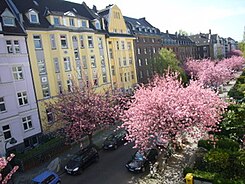Zietenstrasse
| Zietenstrasse | |
|---|---|
| Street in Düsseldorf | |
| A bird's eye view of Zietenstrasse | |
| Basic data | |
| place | Dusseldorf |
| District | Golzheim |
| Created | August 11, 1903 |
| Connecting roads | Kaiserswerther Strasse , Roßstrasse |
| Cross streets | Schwerinstrasse, Mauerstrasse |
| Places | Paul-Spiegel-Platz |
| Numbering system | Orientation numbering |
| Buildings | New Düsseldorf Synagogue |
| use | |
| User groups | Pedestrian traffic , bicycle traffic , car traffic |
| Technical specifications | |
| Street length | 520 m |
The Zietenstraße in Düsseldorf district of Golzheim is a street in a popular residential area that was built in the early 20th century, mainly of buildings from the Kaiser and the inter-war period is characterized. The Zietenstrasse is about half a kilometer long and connects the Kaiserswerther Strasse with the Roßstrasse. At the corner of Zietenstrasse and Mauerstrasse , the street opens up to a small square named after Paul Spiegel , where the New Synagogue is located.
history
The Zietenstraße was laid out at the beginning of the 20th century as part of the urban expansion to the north, named and inaugurated on August 11, 1903 after the Prussian hussar general Hans Joachim von Zieten . It shows a closed development , predominantly with old buildings of the multi-storey type , with a front garden zone as a reference to the urban reform concept of the garden city . The first larger multi-family houses were built in the imperial era. Due to the housing shortage after the First World War , the city of Düsseldorf built over 900 apartments in Düsseldorf in 1925, including numerous on Zietenstrasse. In addition, there were apartments that had been built by civil servants' housing associations. In the 1930s, the area around Zietenstrasse was a stronghold for supporters of the NSDAP . During the Reichspogromnacht in 1938, the apartments of Jewish citizens were looted on Zietenstrasse. The road survived the air raids of the Second World War largely unscathed. On September 7, 1958, the New Synagogue in Düsseldorf was inaugurated on Zietenstrasse, which expanded into a small square there. In 2007 it was named after the President of the Central Council of Jews in Germany , Paul Spiegel from Düsseldorf, who died the previous year .
On October 2, 2000, Zietenstrasse was the scene of an arson attack on the New Synagogue. This attack led to nationwide expressions of solidarity with the Jews in Germany and to protests against right-wing extremism and anti-Semitism under the name Uprising of the decent issued by Federal Chancellor Gerhard Schröder .
Web links
Individual evidence
- ^ Werner Plötz (Ed.): Real estate guide Düsseldorf. Rudolf Müller, Berlin 1998, ISBN 3-932687-03-5 , pp. 31 and 303
- ^ Hermann Kleinfeld: Dusseldorf's streets and their names . Grupello, Düsseldorf 1996, ISBN 3-928234-36-6 , p. 342
- ^ Peter Hüttenberger: Düsseldorf in the Weimar Republic . In: Hugo Weidenhaupt (Ed.): Düsseldorf, History from the Origins to the 20th Century, Volume 3 . Patmos, Düsseldorf 1988, ISBN 3-491-34221-X , p. 392
- ^ Peter Hüttenberger: Düsseldorf in the Weimar Republic . In: Hugo Weidenhaupt (Ed.): Düsseldorf, History from the Origins to the 20th Century, Volume 3 . Patmos, Düsseldorf 1988, ISBN 3-491-34221-X , pp. 429 and 434
- ^ Peter Hüttenberger: Düsseldorf in the Weimar Republic . In: Hugo Weidenhaupt (Ed.): Düsseldorf, History from the Origins to the 20th Century, Volume 3 . Patmos, Düsseldorf 1988, ISBN 3-491-34221-X , p. 616
- ↑ Falk Plan Düsseldorf with a representation of the partially and totally destroyed areas, 1st edition. 1949, Falk-Verlag Hamburg
- ↑ Birgit Kranzusch: "Paul-Spiegel-Platz" officially opened . In: Rheinische Post Online . June 19, 2007, accessed January 11, 2012
Coordinates: 51 ° 14 ′ 35.2 " N , 6 ° 46 ′ 43.1" E
